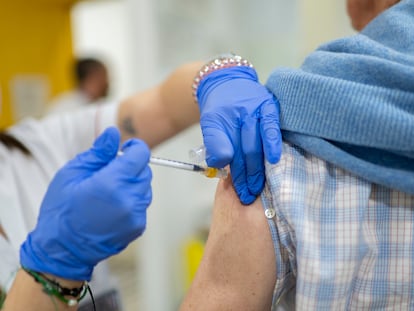One shot, double shield: preliminary success of a combined COVID-19 and flu vaccine in people over 50


The technology that marked a turning point in the coronavirus pandemic, messenger RNA , continues to gain ground in the vaccine ecosystem. New research, published this Wednesday in the journal Jama , has paved the way for optimizing vaccination against two major respiratory viruses: the influenza virus (flu) and SARS-CoV-2 (COVID-19). The trial, developed by the pharmaceutical company Moderna, has found that its combined vaccine achieves an immune response comparable to that of other individual preparations already authorized against these infections. Although this study does not measure the drug's efficacy and will require further research to analyze this key element, the researchers suggest that developing a single vaccine against these two diseases may help improve vaccination coverage.
The flu and COVID-19 viruses are already well-known in public health, but their impact continues to threaten healthcare systems and the lives of millions of people each year: it is estimated that around one billion cases of flu and 2.3 billion cases of COVID-19 are recorded annually worldwide; and despite their virulence, especially in people over 65, vaccination against these microorganisms remains, in the eyes of scientists, "suboptimal." In Spain, vaccination coverage for influenza among the most vulnerable age groups is around 67 %; and for COVID-19 , it is 35%.
The World Health Organization (WHO) actually recommends administering vaccines against these two viruses together to improve coverage, but the authors of this study argue that a multicomponent—that is, a combined—vaccine "may be a preferable option for vaccinating against both diseases in a single injection." The researchers hypothesize that this strategy could increase adherence to immunization guidelines and, "ultimately, mitigate the disease." Time will tell if these expectations are met, but their experimental vaccine, for now, is already at the forefront of this therapeutic strategy.
Interim data from a Phase 3 trial of its mRNA vaccine, which targets four strains of influenza and one of SARS-CoV-2, show that, in people over 50 years of age, a single dose of its vaccine elicits an immune system response comparable to that of other vaccines already authorized by regulatory agencies. The study compares the vaccines with two traditional quadrivalent influenza vaccines and another—from Moderna, also using mRNA—for COVID-19. “mRNA-1083 [the name given to Moderna's new vaccine] induced higher immune responses against all three clinically relevant influenza virus strains and SARS-CoV-2 than the authorized comparator vaccines evaluated in this trial,” the authors explain. It also showed similar levels of tolerance and safety to the comparator vaccines.
The article also highlights the advantages of the messenger RNA platform when designing or modifying vaccines against these two viruses. For example, "the rapid production and flexibility to update the vaccine composition can ensure a close match with circulating strains" of these viruses, they point out.
This is not the only novel experiment underway to combat two respiratory viruses with pandemic potential. Epidemiologist Toni Trilla points out that similar vaccines are being studied by Pfizer-BioNTec and GSK-Curevac, but in earlier stages of research. Also using messenger RNA technology, there are active studies seeking, for example, a universal vaccine against the flu virus, a particularly complex microorganism due to its enormous capacity for mutation and because it is never known with certainty which strain will circulate each season. Beyond messenger RNA, the European Medicines Agency (EMA) has also approved a type of pre-pandemic vaccine , a serum against avian flu that, should a crisis occur due to this pathogen, would be ready to be manufactured.
Caution among expertsRegarding the research published in Jama , Amós García Rojas, former president of the Spanish Society of Vaccinology, points out that it is "a novel project in that it encompasses two vaccines that previously had to be administered separately, but it is not the only line of research related to combined influenza and COVID-19 vaccines," he emphasizes. Regarding the results, he is cautious: "The protective and safety data for both influenza and COVID-19 are positive. In principle, it is a study that gives us hope for this combined vaccine, but we will see how the issue continues to evolve."
Along the same lines of caution, Trilla considers the research "a step forward," but suggests that there are still "many variables to consider in order to argue for or against the possible future use of this type of combined mRNA vaccine for influenza and COVID-19." The epidemiologist points out that, while a vaccine of this type is "easier to manufacture, more quickly adaptable to changes in the predominant strains of both viruses, and easier to administer," it is also "likely to be considerably more expensive. One shot is better than two, but price can be a deterrent: the conventional flu vaccine is much cheaper. And sometimes citizens don't want to get both vaccines (and usually choose the flu). Two are better than one, and one is better than none," the expert explains.
EL PAÍS


%3Aformat(jpg)%3Aquality(99)%3Awatermark(f.elconfidencial.com%2Ffile%2Fbae%2Feea%2Ffde%2Fbaeeeafde1b3229287b0c008f7602058.png%2C0%2C275%2C1)%2Ff.elconfidencial.com%2Foriginal%2F162%2Fd2e%2F70d%2F162d2e70dcd5a48873f495f5e18d34f3.jpg&w=3840&q=100)


